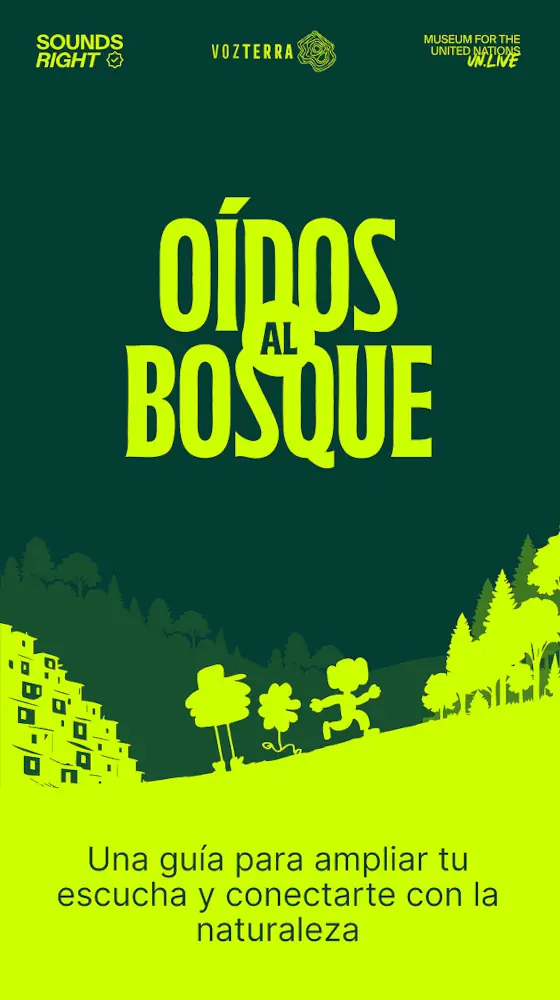Methodological Guide
for Teachers

Created to support teachers in sensitive and transformative environmental education processes, this guide brings together pedagogical proposals that invite them to reconnect with the soundscapes of the land. Each chapter explores a path: meditation, dialogue with nature, and the production of soundscapes with accessible tools.
Guide to Building
a Binaural Recording
Phone Stand

This how-to guide teaches you step-by-step how to build a binaural recording stand using affordable and accessible materials. Designed for teachers and students, it allows you to record soundscapes with immersive quality that simulates human hearing, thus strengthening the sensory and ecological experience of the project.
E-book for Young People

Aimed at teenagers and young adults, this e-book offers an interactive experience to explore sound as the language of Nature. With fun activities and audiovisual resources, it seeks to awaken their curiosity, mindfulness, and a desire to protect their environment.

Meditation Tutorial
Meditation,
One Breath At a Time
In this methodological manual, biologist and meditation instructor Lany Arévalo reminds us that we are easy prey to the anxiety caused by our hectic lifestyles. She teaches how to use meditation to slow down our lives, while preserving our physical and mental health. Entering this ideal state of awareness in the present moment does something else. Something very beautiful: it helps us recognize that we are a fundamental and intimate part of the fabric that makes up the natural world. With her explanations, Lany illuminates what happens in the most remote parts of our brain during meditation, explains its benefits, and at the same time demystifies the misconceptions that exist around it. She leads us by the hand in practical exercises designed both for beginners, and those who already understand the technique of familiarizing themselves with the mind, in order to gradually get to know it and feel that we are part of something much larger.
“Earth speaks to us through every conscious breath we take. To meditate is to tune the ear of our soul to hear Earth's whisper in the wind, the water and even the silence.”
Meditations and Other Materials
The project also includes four video tutorials that summarize the philosophy and methodology of each manual in the voices of its creators, and a series of meditations with Nature to deepen the sensory and emotional connection with the environment.
Walking
Meditation
Stop in the midst of a world moving at the speed of light. Breathe and fully inhabit the present moment.
Stop and Pause
Meditation
A meditation to feel the deep connection with all life on the planet, with which we 'inter-are' at every moment.
'I Am You'
Meditation
A meditation to feel the deep connection with all life on the planet, with which we 'inter-are' at every moment.

Recording Tutorial
Turning Ears into Heart
Designed by sound artist Diana María Restrepo, this teaching guide emphasizes the importance of conscious listening to connect with the world. As part of her extensive research, Diana shares a series of exercises that invite us to engage in dialogue with different actors in the natural realm, opening us to the world beyond humanity. What would that tree tell you about its life story? What questions would you ask it about its relationship with humans? However, it is not just about connection, but about the concepts developed by Alexander von Humboldt and Buddhist monk Thích Nhat Hanh, that nothing exists in isolation: a bird's song wouldn't exist without the forest that shelters it, the seeds that come from it, or the air that vibrates until reaching our ears. This tutorial not only inspires but also nurtures compassion and a commitment to caring for the world. It teaches us the art and practice of deep listening.
“We don't just listen with our ears, but with our whole body. In other words, you listen with your heart, for you become one with the sound.” John Hull

Recording Tutorial
Listening is Remembering
Musician and composer Daniel Roa demonstrates the power of hearing to open doors to the past and windows to the present, allowing us to enter another dimension of a place, beyond what we perceive with our eyes. Just as photographs capture visual instants, sound outlines ephemeral moments that vanish in the blink of an eye, leaving no trace. Listening to soundscapes, then, is a form of care, paying homage to Nature’s past and present. And recording these sounds is a form of cataloging that richness for the future. In this tutorial, Daniel teaches both: first, the art of strategic listening, based on the way we relate to space, plus understanding that soundscapes are composed of various types of sounds. And second, the steps to follow in the process of binaural recording. Binaural is the same as stereo recording, where the sounds of a space are perceived in 360°, imitating the way our ears work. This can be done using our own cell phones.
“The sound imprint is the living memory of a territory.”

Building Tutorial
Guide to Building a Binaural Recording Phone Stand
Recording the fascinating sounds produced by the creatures and forces of Nature in stereo, using two cell phones, first requires learning how to build a specialized mount that somewhat mimics the functioning of human ears. David Castibanco, who has been making low-cost musical instruments from recycled or reused materials for years, teaches us how to do this, in eight detailed steps. The materials are as simple as they are effective: PVC pipe, plastic soda bottles, fabric, cardboard, or foam. The tools are straightforward: scissors, electrical tape, sandpaper, etc. However, it's important to follow the safety rules suggested by David, and avoid confusing the identification of parts. The final product not only works, but is also environmentally friendly.
Building this stand must be done with adult supervision.
Ears to the Forest is part of Sounds Right, an initiative of the United Nations Museum - UN Live and partners like VozTerra that allows Nature to generate royalties and funding from its own sounds.
The Ears to the Forest project was funded by the Udenrigsministeriet (Danish Ministry of Foreign Affairs) and the Museum for the United United Nations -Live.





